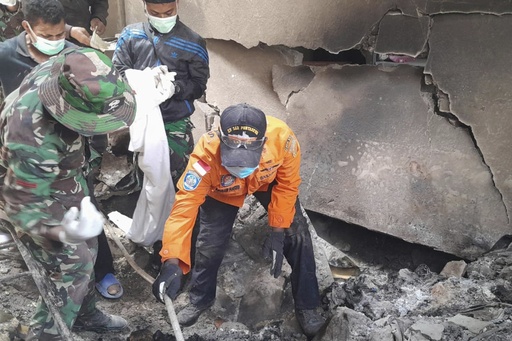
MAUMERE, Indonesia — On Tuesday, rescue teams were diligently searching through the remnants of ash and wreckage, following a violent eruption of a volcano on Flores Island, Indonesia, which took place the previous day. This natural disaster has already claimed the lives of at least nine individuals, with lava and ash wreaking havoc across surrounding areas.
Mount Lewotobi Laki Laki unleashed clouds of dense brown ash that reached heights of approximately 2,000 meters (6,500 feet), discharging scorching lava and debris that spread as far as seven kilometers (4.3 miles) from the crater. This eruption blanketed nearby towns and villages in volcanic material, sparking panic among locals who were forced to evacuate to safety.
Following the eruption, the National Disaster Management Agency revised the reported death toll from an earlier figure of 10, unveiling that one individual initially presumed deceased had been rescued alive but remains in critical condition at a local hospital. The agency has confirmed that a total of 63 people are currently hospitalized, including 31 with severe injuries.
In the wake of the eruption, more than 2,400 residents sought refuge in makeshift emergency shelters set up after the catastrophe destroyed seven schools and 23 homes, including a convent, according to spokesperson Abdul Muhari. The area of destruction was expansive, with thick mud and debris complicating relief efforts, according to local disaster agency chief, Kensius Didimus.
Aid teams are working tirelessly to facilitate evacuation by providing transportation options like trucks and motorcycles, enabling villagers to flee whenever necessary. However, the combination of rain and volcanic ash has led to mudslides, obliterating key roadways on the island, further complicating rescue operations.
Authorities have warned evacuees to refrain from returning to their homes during this period of reduced volcanic activity. Some residents, however, have been eager to return to their properties in search of livestock and personal belongings left behind. Many areas have been enveloped in ash, with destruction evident on everything from furniture to the landscape itself.
Footage released by the National Search and Rescue Agency illustrates the extent of the devastation, showcasing roads smothered in heavy ash and homes engulfed in thick mud, rocks, and toppled trees. The geological agency revealed that a myriad of eruptions that started last Thursday indicated a buildup of pressure due to a magma blockage in the crater, which limited detectable seismic activities.
According to the head of the Center for Volcanology and Disaster Mitigation, Priatin Hadi Wijaya, these eruptions have managed to alleviate some of the pressure building under a lava dome located in the crater. Nonetheless, there remain concerns that the heavy rains could induce additional flows of hot ash and debris from the crater.
Indonesian President Prabowo Subianto has directed his Cabinet, along with relevant disaster management and military authorities, to enhance their coordinated response efforts. The national volcano monitoring agency has raised the alert level of the volcano to its highest status and expanded the exclusion zone to a seven-kilometer (4.3-mile) radius following the increased frequency of eruptions.
Lewotobi Laki Laki consists of two closely related stratovolcanoes in East Flores district, commonly referred to as the “husband and wife mountains.” The term “Laki laki” translates to “husband,” while its counterpart, Lewotobi Perempuan, signifies “woman.”
In a related event earlier this year, over 6,500 individuals were evacuated in January when Mount Lewotobi Laki Laki began its eruptive phase, which also led to clouds of volcanic ash and the temporary closure of the island’s Frans Seda Airport. Although there were no reported casualties from that eruption, the airport has remained closed due to concerns over ongoing seismic activity.
This recent eruption marks Indonesia’s second volcanic incident within just two weeks, following the eruption of Mount Marapi in West Sumatra on October 27, which also released significant columns of ash but, fortunately, did not result in any casualties.
As one of 120 active volcanoes in the region, Lewotobi Laki Laki highlights the ongoing seismic challenges faced by Indonesia, an archipelago housing 280 million residents. The country’s location along the “Ring of Fire” makes it particularly susceptible to earthquakes, landslides, and volcanic eruptions.
